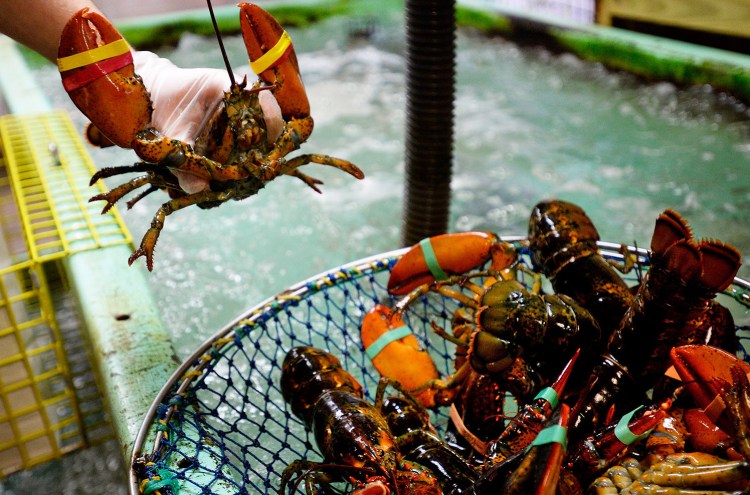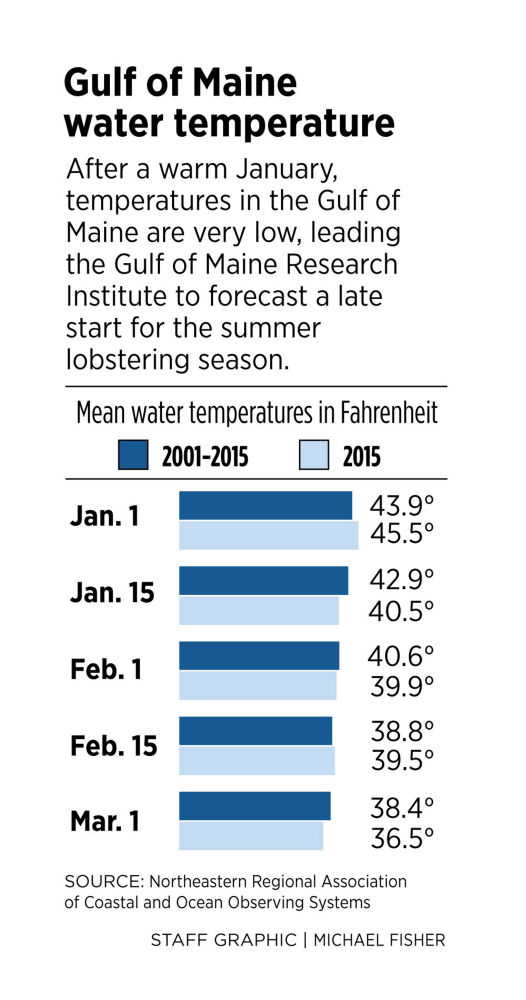The first-ever lobster forecast is out, and it says February’s record cold will likely set back Maine’s lobster season.
There’s a 69 percent chance that Maine’s summer lobster harvest will begin later than usual, according to the forecast issued Thursday by the Gulf of Maine Research Institute. That has ramifications for both harvesters and the supply chain for Maine’s most lucrative seafood.
This winter’s below-normal temperatures and stormy weather have cooled the waters in the Gulf of Maine. That means lobsters, which spend their winters in deeper waters offshore, will likely get a late start migrating to the coast and shedding their shells, says Christina Hernandez, a research assistant working on the project, which is being funded with $100,000 from NASA.
The forecast is based on 13 years of data on lobster landings and water temperatures measured 50 meters below the surface at four buoys off the Maine coast, from southern Maine to Down East.
For example, at the buoy off Wells, the reading 50 meters below the surface was 36.6 degrees on Wednesday – a record low since the buoy began recording data in 2001. At the surface, the water temperature was 36 degrees, about 2 degrees below normal for this time of year.
In January, water temperatures in the Gulf of Maine were near record warm levels. But cold weather in February chilled those waters. In Portland, the average monthly air temperature in February was 13.8 degrees – 11.7 degrees below normal. It was the coldest February since recordkeeping began at Portland’s airport in 1940.
In Bangor, where records go back to 1926, the average air temperature was 6.1 degrees in February, beating out the previous record low of 11.3 degrees, set in 1993.
The series of storms in February mixed up the water column and drove cold temperatures at the surface to lobster habitat at the bottom, Hernandez said.
The Gulf of Maine Research Institute plans to issue its forecast every Wednesday through April. The accuracy will improve each week and reach its most accurate level on April 15, according to Hernandez.
A HEADS-UP FOR HARVESTERS
Early indicators of lobster movement could help the industry prepare for the kind of conditions that occurred in 2012, when unusually high ocean temperatures prompted lobsters to shed their hard shells and migrate toward shore several weeks earlier than usual, causing a market glut because processors and buyers weren’t ready to handle the volume. As a result, lobster prices plummeted.
Lobsters molt so they can grow into new, larger shells. A molted lobster, which has a soft shell, is typically called a “shedder.” After lobsters shed, they are hungrier and move around more and are easier to catch.
The forecast won’t surprise Maine lobstermen, because they’ve noticed how cold the ocean is, said Patrice McCarron, executive director of the Maine Lobstermen’s Association.
She said a late start is much better than an early start because the lobsters will arrive when the summer tourists are in Maine to buy them. Also, capacity at processing plants won’t be an issue because the last open Canadian lobster fishery will have closed by the end of June, she said. “The later start aligns us with the market.”
Usually, Maine’s lobster industry kicks into full gear around July 4, when just about every fisherman has traps in the water. But there’s a good chance that this season will begin in earnest a week or two later, Hernandez said.
The forecast shows a 31 percent chance that the season will start on time, a 36 percent chance that it will start a week late, a 31 percent chance that it will start two weeks late, and a 2 percent chance that it will start three weeks late.
While the current forecast leans strongly in favor of a late harvest, extreme fluctuations in inshore water temperatures may yet change the outcome, said Andrew Pershing, chief scientific officer at the Gulf of Maine Research Institute.
“We started out January at near-record warm temperatures in the Gulf of Maine, and there is still a large amount of warm water offshore,” he said. “If circulation patterns bring the warm water into the inshore region, we could see temperatures warm up quickly and bring an early start to the busiest time of the year for lobstering.”
Send questions/comments to the editors.




Comments are no longer available on this story